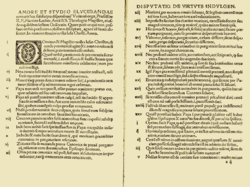
A | B | C | D | E | F | G | H | CH | I | J | K | L | M | N | O | P | Q | R | S | T | U | V | W | X | Y | Z | 0 | 1 | 2 | 3 | 4 | 5 | 6 | 7 | 8 | 9
| Catholic–Protestant relations | |
|---|---|
| Separations | Reformation (16th century) |
| Members | Catholic: 1.313 billion (2017, self-declared)[1]
Protestant: 1.17 billion (2024)[2] |
| Part of a series on the |
| Catholic Church |
|---|
 |
| Overview |
|
|
| Part of a series on |
| Protestantism |
|---|
 |
|
|
| Part of a series on |
| Christianity |
|---|
 |
Catholic–Protestant relations refers to the social, political and theological relations and dialogue between the Catholics and Protestants.
This relationship began in the 16th century with the beginning of the Reformation and thereby Protestantism. A number of factors contributed to the Protestant Reformation. Namely, disagreement on the nature of salvation and by extension a number of doctrines including the sale of indulgences and more. These disputes led to a schism whereby Protestants chose to split from the Roman Catholic Church and resulted in the Council of Trent (1545–1563) which clarified the Catholic approach to Protestantism from then on, declaring all forms of Protestantism heretical. A series of significant events followed which divided Europe and culminated in a number of states transitioning from Catholicism to Protestantism as their state religion. However, many remained Catholic, and some areas reverted to the Catholic religion as a result of the Counter-Reformation. Much of the schism and the events it caused can be categorised as violent and tumultuous. However, with the rise of secularism, Catholic–Protestant disputes are generally constrained to the intellectual sphere.[3][4]
Theological disputes
Catholic–Protestant theological dissent was birthed in 1517 with the posting of Martin Luther's Ninety-five Theses which outline ninety-five objections against Catholic doctrine. These included distinction between clergy and laity, the Roman Church's monopoly on scriptural interpretation, the sale of indulgences, the nature of salvation, and more.[3]
Salvation
Luther's understanding of salvation was one of the radical departures from Catholic dogma. Luther highlighted that Christian salvation was a free gift from God which led him to criticise the sale of indulgences as a means by which one can attain heaven. He stressed the importance of a faith-oriented process of salvation, distinct from his view of the Catholic works-oriented salvation. This also led to a shift in the understanding of grace.[3] This Protestant doctrine is known as sola fide ("faith alone").[5]
French attorney John Calvin developed the Reformed theology of salvation. While Luther maintained that salvation was available to all, Calvin introduced the doctrine of predestination. Based on the idea of human's sin-enslaved will, and salvation being the sole work of God (not man), Calvin insisted that certain individuals were predestined for heaven and others were not.[6]
Authority
A significant foundation for both parties' doctrines is the nature of their authority. The Protestant positions consists in either holding scripture to be the sole foundation of Christian doctrine (as with e.g. Lutheranism), or holding that scripture is the primary source of Christian doctrine (as with e.g. Anglicanism and Methodism).[7][8][9][10][11] This has led to heavy criticism of the Catholic Church's position which places scripture on par with Sacred Tradition, with Catholics considering both as divinely revealed and binding.[11] The Catholic Church considers itself the "one true church" founded by Jesus as necessary for salvation.
History
16th century – The Reformation

| Part of a series on the |
| Reformation |
|---|
 |
